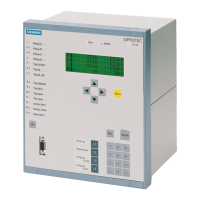2 Functions
290
7SD5 Manual
C53000-G1176-C169-1
In the event of a single cycle reclosure this interrogation is usually sufficient. Since, for
example, the air pressure or the spring tension for the circuit breaker mechanism
drops after the trip, no further interrogation should take place.
Especially when multiple reclosing attempts are programmed, it is recommended to
monitor the circuit breaker condition not only prior to the first, but also before each fol-
lowing reclosing attempt. Reclosure will be blocked until the binary input indicates that
the circuit breaker is ready to complete another CLOSE-TRIP cycle.
The time needed by the circuit breaker to regain the ready state can be monitored by
the 7SD5. This monitoring time CB TIME OUT starts as soon as the CB indicates the
not ready state. The dead time may be extended if the ready state is not indicated
when it expires. However, if the circuit breaker does not indicate its ready status for a
longer period than the monitoring time, reclosure is locked out dynamically (see also
above under margin heading „Blocking of Auto-reclosure“).
Processing the
Circuit Breaker
Auxiliary Contacts
If the circuit breaker auxiliary contacts are connected to the device, the reaction of the
circuit breaker is also checked for plausibility.
In the case of single-pole tripping this applies to each individual breaker pole. This
assumes that the auxiliary contacts are connected to the appropriate binary inputs for
each pole („>CB1 Pole L1“, No. 366; „>CB1 Pole L2“, No. 367; „>CB1 Pole
L3“, No. 368).
If, instead of the individual pole auxiliary contacts, the series connections of the nor-
mally open and normally closed contacts are used, the CB is assumed to have all
three poles open when the series connection of the normally closed contacts is closed
(binary input „>CB1 3p Open“, No.411). All three poles are assumed closed when
the series connection of the normally open contacts is closed (binary input „>CB1 3p
Closed“, No. 410). If none of these input messages is active, it is assumed that the
breaker is open at one pole (even if this condition also exists theoretically when two
poles are open).
The device continuously checks the switching state of the circuit breaker: as long as
the auxiliary contacts indicate that the CB is not closed (three-pole), the automatic re-
closure function cannot be started. This guarantees that a close command can only
be issued if the CB previously tripped (out of the closed state).
The valid dead time begins when the trip command disappears or signals taken from
the CB auxiliary contacts indicate that the CB (pole) has opened.
If the CB opens three-pole after a single-pole trip command, this is considered as a
three-pole tripping. If three-pole reclosure cycles are allowed, the dead time for three-
pole tripping becomes active in the control mode with trip command (see margin
heading „Control Mode of the Automatic Reclosure“); in control by pickup, the pickup
configuration of the starting protective function(s) is still decisive. If three-pole cycles
are not allowed, the reclosure is locked out dynamically. The trip command is final.
The latter also applies if the CB trips two poles following a single-pole trip command.
The device can only detect this if the auxiliary contacts of each pole are connected in-
dividually. The device immediately initiates three pole coupling thus resulting in a
three-pole trip command.
If the CB auxiliary contacts indicate that at least one further pole has opened during
the dead time following a single-pole trip, a three-pole reclose cycle is initiated with the
dead time for three-pole reclosure if this is allowed. If the auxiliary contacts are con-
nected for each pole individually, the device can detect a two-pole open CB. In this
case the device immediately sends a three-pole trip command provided the forced
three-pole trip is activated (see Section 2.15.2 at margin heading „Forced three-pole
Trip“).
www . ElectricalPartManuals . com

